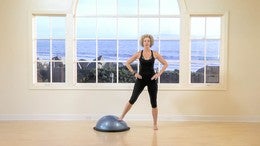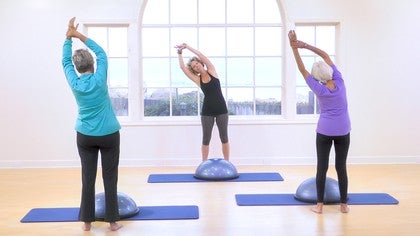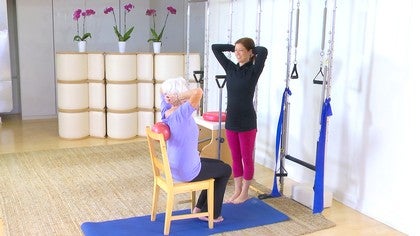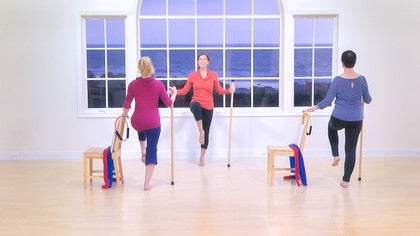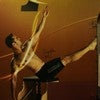Description
If you don't have a BOSU®, many of these games can be done with other balancing props or nothing at all.
About This Video
Transcript
Read Full Transcript
Hey everyone, welcome. You are so in for a treat today. I am here with two beautiful young ladies, one of which is my 74 year young mom and 78 year young Helen and we are going to do a class for the active aging population. We're using the Bosu balance trainer. This is a great lay bile surface to really train balance.
After we hit 30 our balance starts to really stunt and it's very important to train balance on a regular basis, not only in the standing position but in all six body positions, which we will be doing in this class today. So I hope that you enjoy it. If you don't have a balanced trainer, feel free to use any balanced product that might do the same thing, maybe a wobble disc or something of that nature of many of these games because we're not exercising in this class. Many of these games that we will be doing, you could do actually without the Bosu balance trainer, but if you have one, it's a great tool. I also want to let you know that many of these games are going to be improving or helping us improve on sentencens or the science of aging. Did you know that there's five types of aging and four out of the five can be improved upon? The only one that cannot is our chronological age. So I am 40 years em and I will never be 39 again.
I can wish and I can help, but I won't. If you have any curiosity on that, I shot a couple of other tutorials. Those are available in the [inaudible] anytime education area. Feel free to take a look at those and I go into much, much more details. So are you young ladies? Ready? Good. So I'm going to have you come around and face me.
So you're going to be standing on the floor and I want you to take a little bit of a wider stance. What not. Let's not be so worried and so perfect that we're stacked right underneath our hips. Just a little soft. Bend the knees here and just take a nice deep inhale, sip the air in and bring your arms up above the head and then exhale, draw the arms back down. So we're just going to enjoy just a nice easy warm up here. And one thing to think about here is that you want to warm yourself up for a little bit longer in your classes when we are actively aging or when we're in the active aging category or when you are working out with me as an active age or that's really important and it's also important to be warming ourselves up in all three paint planes of motion. So let's change that here. You're going to lift those arms up and stay up there with me and I want you to hold one hand and we're just going to tip over to the side and side bend and feel what's happening from slide to slide. Come back up to standing.
Lower those arms back down and your range of motion is really contingent upon what your spine can give to you. I don't know what's happening in your body. You are definitely different people, both of you and you're different than me and you at home are different. And so do what feels best to your spine and your body. Good. And we're gonna do one more here. Lifting the arms up and lengthening over to the side and then drawing the arms back down. Very nice.
So take the arms now out to the t and I want you to rotate the biceps or the palms of the hands up. Good. And now from here I want you to just spiral around the body and twist and rotate. Take your eye gaze with you, right? So you want to shift your neck as well. Good. And come back to center and you rotate. And as we start to move into these games or sequences, remember it is not about perfection here.
When we're training balance and we're challenging balance, it is about having fun and not being fearful. So just know that there is no judgment in this class at all whatsoever, which should feel really nice. And your arms should be warming up right now and rotate. Good. Back to center. And last one here. Come back to center and let those arms rocks down. Shake out your arms.
And from here widen out your stance again. And all they want to do is carry on that twisting motion. But I want your arms to just be nice and passive here. So just let your shoulders relax and you twist good. And just relax your shoulders, swing your arms good and rotate.
And just notice what's happening with your eye gaze. Are you able to keep it up on the horizon or do you feel like you need to look down a little bit? It's no judgment. I'm just asking you to look at what's happening in your body and with your, with your visual effect right now. Two more times. And last one. Good job. So quiet those arms. And we're going to start by playing our first game, which is called bubble wrap.
So I want you to imagine that this balance trainer is a nice big piece of bubble wrap and you're going to start to try and pop it with your feet. Okay? And we're going to play a little bit of a brain game as we do this. So before we start that, just start to push one foot into the dome. It doesn't matter where, it could be right in front of you, it could be over to the side. But ultimately what I'm trying to do is trying to get your toes to still point up towards your knees as you're doing this, as you're getting more comfortable, notice where your eye gazes.
Can You keep it up or did you have to look down? One of the cues I like to give here is please look down as much as you need for your safety, but once you feel confident as little as possible because life is here, life is not down on the floor. Okay? So carry on with your movement and now we're going to start to challenge your brain. So the last four digits of my cell phone number are nine four zero zero what are the last four digits of my cell phone number?
So the first three digits are eight four two the last four digits are nine four zero zero. What are the seven digits of my cell phone? Number two. You got it. Very good job. Well done. So go ahead and quiet those feet. So neuroplasticity, neuroplasticity, science says that we have to move and challenge our brain to actually prove, improve on the power of our brain and really impact our activities of daily life. There is an example of one side of the brain. From here we're going to put one foot up onto the Bosu balance trainer and I just want you to start to roll that ankle a little bit.
Just start to feel the surface area and roll out that ankle and just notice that lay bile surface. Then maybe notice what you're doing with your back foot. Like, I can feel my back foot's kind of turned out. I might want to try and correct that or not. And then reverse the direction of your ankle roll. So just getting a bit of ankle mobility going on. Don't worry, you're not going to be doing a back flip on it, I promise.
And then let's switch your feet and see if you feel anything different. And just go ahead and roll. We're preparing ourselves for the next game, which is called hot cold. Okay, this is a reaction drill. So this is all about reaction. And why do we need good reaction? Because if you get out of your car and you trip on a curb, I want you to have good reaction time so that you catch yourself and that you don't go all the way down onto the ground. Correct. So from here, let's switch back over to the other foot in just a moment.
I want you to imagine that this boasty balanced trainer is now 250 degrees and it's really, really hot. But when I say the word cold, you can actually put your foot on it. So it's cold. Let's put our foot up. So now we're training, balance and gates. Single leg. Believe it or not because it's hot to lift the foot.
And notice don't put me as the center point. Watch the movement of these two young ladies here. So put that other foot up. And from here it's cold so you can hang out. So get set with that tree trunk leg and see what you're working with. And notice if you just feel like you need to have your arms up or however you feel in your is fine. Just try and not take stress in other areas.
And now it's hot.
So from here, we're going to start that bubble wrap again and now we're going to play with neuro-plasticity for the other side of the brain. This time. What's different? Watch your mats. I want you to start to navigate yourself around your dome. Okay? So I want you to start to make a circle. So we're changing what's happening with your visual field.
You can go as slow or as fast as you want. It doesn't matter to me. I just want you to do it. Start to navigate around and feel that label surface of the dome. Good. And carry on. Of course, what you don't realize is that I'm tricking you into a little single leg standing balance. Each time you lift that foot and press it in. So I'm going to tell you a story and now you're going to reverse your circle.
So you're going to start to circle in the other direction. And Southern California, we had a really hot winter this year. Unfortunately, there happened to be one weekend where it was cold enough for me to go to the market and buy eight and Green Granny Smith apples. That cost me $8 and 42 cents. Do either of you remember how many apples I bought? Good. Can you spell the word eight for me?
Very good. And what kind of apples did I purchase and what color are granny Smith apples. Great. Can you spell the word green? Keep moving. G. R. E. E. N. Very good. Go ahead and quiet that. So you'll notice that we did a numbers game and a letters game and all the while you were moving. So you are challenged, your brain, your balance, and your movement all at one time. So now we're going to move into a safe kneeling position.
So I want the both of you to come over your perfect where you're at. And I'm going to do this with you. So standing facing the side of your dome from here, safe kneeling. We've now brought the floor to you and we've brought a comfortable position. So take your hands, slide them down onto your knees, bend those knees than reach forward.
Find the dome and bring yourself down to a floor position. And Wallah you're there. And once you're there, of course you're going to have to make micro adjustments and that's fine. We're going to do a visual effect game. Take your arms up, thumbs up. Now I want you to take your right arm up into the right as you look at that thumb and notice what happens in your body. Bring it back down. Take your left arm up into the left to remember. No judgment here, right? If you feel wiggles and wobbles in the body, that's great.
Now go down into the right
Now we're going to come down and put our hands on the floor to a more stable position. Now we're still in balance because we're on our knees in quadrant pen and I want you to pretend you're a cat. So we're going to do a little cat. So mobility of the spine as you round it up to the ceiling and then coming here through into a little bit of back extension. If that feels good to you. And then again around fine, I'm calling you into a slight bit of back extension. Now your mobility is contingent upon what your spine can do for you and that's fine. Everybody's different.
None of us are the same and that's a good yeah thing. Last one around and come in to slight extension. Now hold here as we do a bit of thoracic rolling. So I want you to start to make a circle with your rib cage. So you're rolling it up and over in one direction. Good.
And a couple more. Breathing, how you feel natural, and then reverse your direction here you're going to reverse that thoracic role and enjoy it. And maybe you're starting to feel more confident and you want to take your toes up off the floor, or maybe you're not and that's fine. Do what feels good for you. And then take the time to quiet the spine. Come back up onto your knees, and we're going to do a bit of backstroke. So we're combining the visual aspect that we did earlier with a little bit of shoulder mobility. Now remember, shoulders are all different.
So do what feels good to you. Arm comes back and you look back at that arm if you can, and the other arm comes back
You go up, you're doing great and last one lift. And that is plenty of time on your knees. So let's move down into the side positions. You're going to come down and bring your hip onto dome. Exactly. That's great. Now you have options here.
Less stable hand stays here. More stable hand goes to the floor. Okay? The first thing we're going to do is butterfly. This is great for hip mobility. From here, you're just going to lift that top knee and lower it down [inaudible] and just notice where that, and he goes to go higher. Miko lower on the other side and there's nothing wrong with that.
Lifting and lowering. Good and lifting and lowering. So now we want to get the quadratus lumborum a little bit more engaged, another critical area for fall prevention and reaction times. So put your hand down onto the floor, lift your feet into perched clam. Now you're engaged right through here and you're going to go into that butterfly again. Okay, so lift, it's fine. Just do little little bitty adjustments here.
That's what balance training's all about. You're going to always have to make those micro adjustments. We're not going to do 42 more. And last one. The third thing we're going to do in the side series is my favorite exercise.
It's called banana split. Okay. You're going to come down onto your forearm and remember there's no judgment. You're probably going to have to move your body here and there and that's fine. The leg swings slightly forward into a banana shape, so your body isn't a banana. [inaudible] and we're going to banana split.
Good and come all the way down. And banana split. You're making this look way too easy. And lower. And banana split. Lovely. Good job. Two, these young ladies. Three more and split. So again, hip mobility, abduction, quadratus, lumborum, all really critical, but we're still training. Balance on the side. Two more. Lift, split and down. Last one, and lift and split and down. Give that a rest.
Let's go ahead and come to the seated position up on top of your dome facing me. Now if you'd like to extend the legs long, pull the toes up towards, towards the knees. So again, we're going with that Dorsiflexion of the foot, the activation of the anterior Tibialis, and we're just gonna take some spine stretch forward yet. Arms reach forward, palms of the hands face towards one another. And you're just gonna roll down towards your toes, lengthening out the back line of the body, and then lifting and drawing back up. Now can you sit up maybe a little bit taller before you round and roll forward, reaching maybe a millimeter further and lifting back up. So I'm just giving you a bit of a transition before we move to the other side and roll down in reach and bring it all the way back up.
Last one here and roll down in reach and come all the way back up. Now before we move to the other side, rotate the hands up. Open the arms. We did this standing on, not in balance. Now we're going to do some spine twist. So exhale you twist and inhale to center and exhale you twist and inhale center. Now I don't want to see those feet moving too much, right?
That tells me that you're moving at your hips. Just getting a little bit of rotation happening and rotates and center. Good and rotate. Can you draw your toes to your knees? Anymore? Rotates and center. Two more times. Twist and center and last time and centers.
So it's time to go to the other side. Did your arms get a little warm? Yeah minded too. Okay. So let's transition over to the other side. And remember we're going to start with butterflies. So your feet are stacked, your hip is up on that dome. You can have your hand here for less stability on the floor for more stability. Okay. And then we just lift and lower that top leg, butterfly, hip mobility and lift and lower. Good.
And lift and lower. Three more times. And then we'll go into the more perched challenging variation. Nice. And one last time here. Lift and lower than, let's put that hand down on to the stable floor surface purchaser clam. So you got a little clam out in that water behind us. And from here you're gonna carry on with that hip mobility.
And notice what might be happening from side to side. You might feel a little different on this side and that's fine. We have a strong side and we have a smart side or a lazy side for a reason. Last to that lazy side has been cheating on us our whole life. Last one. Good. And Go ahead and lower those feet down.
Final exercise for our side on the other side is banana spits. Split split from here, come down onto your forearm, make that banana shape of the body. And here we go. We banana and split. Good and banana on split. So you'll notice that most of these games I've named really fun games and these are also, some of them are Curtis courtesy of a good friend of mine.
Lawrence is gone Teenie, so I need to pay homage to him. Two more ladies, you're doing great because we're not exercising. We're playing games, right? Last one and the lift. Super Job. So now we're going to come back to that seated position. You both will be facing one another, okay? And remember this is where we're going into a low writer position.
Okay? So you're going to have to move the bottom down the dome a little bit. Now you don't want to come all the way to the base, okay? I want your legs to be comfortable. Hip distance may be a little wider. Whatever feels good to you and your roll back is also contingent upon what feels good to you. So grab onto the backs of your thighs to start. Lift your spine tall. Feel that link first.
Then I want you to lightly begin to roll back in a hollow the belly. Just a little, just a little. You both look great. Stay there. Can you let go of your arms? Give yourself a test. Did you feel your abs kick on? Yes. Yes. Okay. That's a yes from here. Hold that low writer position.
Take your arms away from the body to challenge and bring it back. Feels good to open the arms on an inhale and exhale, bring it back. You're doing great. You got 48 more and bring it back. Two more. Inhale you open. Exhale, bring it back. I got a smile out of both of them and last one. Now grab onto the backs of your thighs. Give yourself a little rest.
Now we've talked a lot about the need for mobility versus stability. We're going to add in also visual effect here by doing a side reach. So let's find your low rider again. Hold that position. Give yourself a test. Are you still able to hold that position from here? You're going to open one arm out and look to it. Yes. Lovely.
And bring it back to center. Other side, I don't care which side you you started with. Just go with what feels good to you. Remember, there's no judgment. We're still training. Balance in the seated position and open and bring it back. Good. Four more times.
You've got this four and back and three and back. Super Two more times. Bring it back and last time here and bring it back. Find the backs of the thighs. Lift yourself back up tall. Take your hands, bring them onto the side of your dome and scoot your bottom all the way down to the floor. One of the benefits of having this surface area behind this is we can do a lovely supported, supine inclined position so your head will be above your heart while we train your hamstrings and your gluteals critical muscles for your gait.
Fall prevention and reaction time safely. Bring yourself down onto the dome. When you get your head up on top of the dome. I don't want to have any tension in the front of the neck. You should feel nice and comfortable.
So if you feel like you have tension in the front of the neck, you'll probably have to adjust yourself. So my 78 year young Helen needs to move up just a little bit higher. Yes, that's good. Now draw your heels a little closer to your bottom. Great Press. Put pressure into the palms of the hands. And I want you to lift the pelvis up into a nice supported bridge position.
And then lower the hips straight back down. Now visualize that you have a piece of whole wheat bread on the front of your body and a piece of whole wheat bread on the back of your body. And I want you to just hinge upwards from the hips as if you have a peanut butter and jelly sandwich. So everything is nice and stable here and lowering down. So feeling your gluteals in your hamstrings. Kick on. Good.
Last one here like this. So lift up and lower. Now let's change it for your brain. Draw your toes to your knees and rock back on your heels. So you're again in that dorsiflexed position, activating the anterior to be Alice. If you'd like to challenge yourself, you can lift your arms up to the ceiling.
As you lift into that bridge and you lower back down. As a reminder, changing your contact points is going to change the challenge of the balance. So just lifting and lowering. So do what works best for you or just keep your hands down at all times. That's totally fine.
Last one like this and lower back down. Now from here, leave your left set of toes pulling up towards the knee. And I want you to point up onto your right set of toes, elevating that right heel and you're going to carry on lifting and lowering into that bridge position. But noticing that one foot is dorsiflexed and the opposite foot is now plantar flexed and lift and lower and last one. And then of course we're going to switch and put that right heel down and elevate the left heel. And here we go. We lift and lower. So again, your right foot should be dorsiflex, meaning the toes pulling to the knees and your left foot.
Your heel should be off the ground and you should be on your toes. Last two beautiful and last one, lowering back down. The most challenging here is to do a single leg bridge, but that is really something that the research says is very, very beneficial for us as we age. So from here I want you to lift your right leg into the tabletop position and we'll do three from side to side. Here we go. Push up for one and lower down. Push up for two strong ladies.
Push up for three and lower down. Switch your feet immediately. Bring that other leg up. And here we go. Push up for one. Notice what's different, right? That biofeedback with the Bosu underneath us changes things last one and lower. Well done both feet. Come back down.
Now take your time, turn onto your side. We're moving into the prone position for the super person game. Okay, so I'm going to have you guys move or you ladies move all the way around to the other side of your dome and we're going to bring our pelvis onto the dome. Now again, you may need to make micro adjustments here and that's fine. The first thing I want you to do is put your forearms down and I just want you to let your belly go. Just let it go into the dome. Okay. Now imagine that that Bosu is a weight scale and I want you to pull your navel into your spine, lift your abs in as if you are unweighting that dome.
Do you feel that? Yes, your abs are now engaged. That's what we want. Now if you haven't already, Tuck your toes under an extend your legs long. Now from here I want stability of the spine, so you're going to keep the spine where it's at and come into super person by just lifting your arms out to a goal post position. Good. And here you may need to slide back a little bit. Yes, that's fine. If you haven't set yourself up perfectly, that's fine.
The sweet spot is where you want to be at and you need to shift a little bit and try that again. So stability of this fine heads in line with the heart and with the tail, right? So we're not lowering the head and lift those arms. Now we want to take some mobility. So what I want you to do is lift the arms and now draw your pinkies to your hips and your thumbs to your ceiling and find a little bit of thoracic back extension. Good. And then come back down.
Put your forearms down. Let's do that again. Lift the arms up and then lifting higher in the back. Extension. Thumbs up if you can. Good. And then come all the way back down. One more of those finding super person to start. And then taking your Cape and bringing it all the way back down to your hips.
Good. And then go ahead and rest again. That belly just rests into the dome. And what I'd like for you to do is move back down onto the floor and lie your side all the way over the dome. You can face me. So you can see me and just cradle your neck in your hand. Yes. And your knees are just tucked up towards you, your good and your arm, your top arms. Just going to reach forward. And from here I just want you to give yourself a little rollback.
Good. Wonderful. I'm going to have you both turn and over onto your other side. You can stay on that side of the dome. All it will be the ones who move [inaudible]. And remember, you're just gonna have, so just turn face that direction. You can stay on that side of the Dome, cradle your neck in your hand and you're just going to do a little bit of rolling back.
Enjoy that and rolling forward. Good. And Rolling back. And again, taking an arm circle if that feels good to you and rolling forward. Nice. And one more. Rolling back and rolling forward. And from here I want you to safely take your time because you're coming from a floor position to a standing position. So take your time, come and fo face your balance trainer.
Come on to your knees and then bring yourself all the way back up to standing and come back around and stand behind your dome. Good. You can come around to the other side and face the beautiful ocean. And from here we're going to lift the arms up nice and slow, letting the arms and be an extension of the spine, lowering and back down. Good. And lifting them back up and lowering them back down. Good. Now widen out your legs. Bend your knees slightly and just give me a little hollow of the belly in rounding the spine, letting your low back release, and then come back, shining the chest forward and going again.
Rounding that spine up and then shining the chest forward. Last one here and around. Good. And then coming forward. And last thing to do. Stand up with me. Take your arms up above the head, flex your wrist. Imagine you're the most beautiful flower because you both are, and I want you to open your flower pedals all the way open and to the side.
And thanks for playing some games with me today.
Active Aging: Improving Balance
Comments
You need to be a subscriber to post a comment.
Please Log In or Create an Account to start your free trial.
